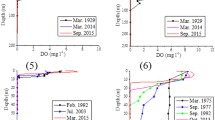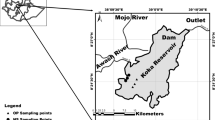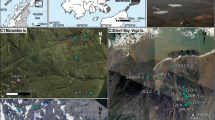Abstract
Valle de Bravo (VB) is a tropical reservoir located (19°21′30″ N, 100°11′00″ W) in the highlands of Mexico. The reservoir is daily swept by strong (7.4 m s−1 mean speed) diurnal (12:00–19:00 h) winds that blow along its two main arms. As expected from its fetch (6.9 km) and its depth (21.1 m mean), the reservoir behaves as a warm monomictic water body. During 2001, VB was stratified from February to October, and well mixed from November to January. Its mean temperature was 19.9°C; the maximum found was 23.8°C in the epilimnion, while a minimum of 17.8°C was registered during mixing. VB exhibited a thermal regime similar to other water bodies of the Mexican tropical highlands, except for a steady increase of its hypolimnetic temperature during stratification, which is attributed to entrainment of epilimnetic water into the hypolimnion. During stratification, the hypolimnion was anoxic, while the whole water column remained under-saturated (60%) during mixing. The flushing time is 2.2 years. Mineralization and total alkalinity are low, which allows strong changes in pH. Ammonia remained low (2.4 μmol l−1 mean) in the epilimnion, but reached up to 60 μmol l−1 in the hypolimnion. Soluble reactive phosphorous had a mean of 0.28 μmol l−1 in the epilimnion and a mean of 1.25 μmol l−1 in the hypolimnion. Nitrate exhibited maxima (up to 21 μmol l−1) during mixing, and also in the metalimnion (2 μmol l−1) during stratification. Low dissolved inorganic nitrogen indicated nitrogen limitation during stratification. Eutrophication is an emerging problem in VB, where cyanobacteria dominate during stratification. At VB chlorophyll a is low during mixing (mean of 9 μg l−1), and high during stratification (mean 21 μg l−1), when blooms (up to 88 μg l−1) are frequent. This pattern is similar to that found in other eutrophic tropical water bodies. We propose that in VB the wind regime causes vertical displacements of the thermocline (0.58–1.10 m hr−1) and boundary mixing, enhancing the productivity during the stratification period in this tropical reservoir.







Similar content being viewed by others
References
Alcocer J, Lugo A, Escobar E, Sánchez MR, Vilaclara G (2001) Water column stratification and its implications in the tropical warm monomictic lake Alchichica, Puebla, México. Verh Internat Verein Limnol 27:3166–3169
American Public Health Association, American Water Works Association, the Water Pollution Control Federation (1989) Standard methods for the examination of water and wastewater, 15th edn. APHA-AWWA-WPCF, Washington, DC
Armengol J, García JC, Comerma M, Romero M, Dolz J, Roura M, Han BP, Vidal A, Simek K (1999) Longitudinal processes in canyon type reservoirs: the case of Sau (N.E. Spain). In: Tundisi JG, Strataskraba MS (eds) Theoretical reservoir ecology and its implications, San Carlos international institute of ecology, Brazilian academy of sciences and backhuys publishers pp 313–345
Davies SJ, Metcalfe SE, Mackenzie AB, Newton AJ, Endfield GH, Farmer JG (2004) Environmental changes in the Zirahuén Basin, Michoacan, Mexico, during the last 1000 years. J Paleolimnol 31:77–98
Deguchi J, Nakazawa A, Gutiérrez C (1980) Studies on interspecific relation of fishes in the dam Valle de Bravo, México–I On the environment. Bull Coll Agr Vet Med Univ 37:254–259
Dokulil MT, Teubner K (2000) Cyanobacterial dominance in lakes. Hydrobiologia 438:1–12
Eugster HP, Hardie LA (1978) Saline lakes (p 237–293). In: Lerman A (ed) Lakes: chemistry, geology, physics. Springer-Verlag, New York, p 385
González EJ, Ortaz M, Peñaherrera C, Infante A (2004a) Physical and chemical features of a tropical hypertrophic reservoir permanently stratified. Hydrobiologia 522:301–310
González EJ, Carrillo V, Peñaherrera C (2004b) Características físicas y químicas del embalse Agua Fría (Parque Nacional Macarao, estado Miranda, Venezuela. Acta Cient Venez 55(3):225–236
Henry R, Do Carmo CF, Bicudo DC (2004) Trophic status of a Brazilian urban reservoir and prognosis about the recovery of water quality. Acta Limnol Bras 16(3):251–262
IDECA, SA de CV (1999) Estudio Limnológico de la presa de Valle de Bravo, México. Informe para la Gerencia Regional de Aguas del Valle de México, Comisión Nacional del Agua, México, D F
Jeffrey S, Humphrey G (1975) New spectrophotometric equations for determining chlorophylls a, b, c1 and c2 in higher plants, algae and natural phytoplankton. Biochem Physiol Pflanz 167:191–194
Kalff J (2002) Limnology: inland water ecosystems. Prentice-Hall, Inc, Upper Saddle River, NJ, USA
Lewis WM Jr (1983) A revised classification of lakes based on mixing. Can J Fish Aquat Sci 40:1779–1787
Lewis WM Jr (1996) Tropical lakes: how latitude makes the difference. In: Schiemer F, Boland KT (eds) Perspectives in tropical limnology. SPB Academic, The Netherlands, pp 43–64
MacIntyre S, Jellison R (2001) Nutrient fluxes from upwelling and enhanced turbulence at the top of the pycnocline in Mono Lake, California. Hydrobiologia 466:13–29
Martínez-Romero E, Martínez-Salgado MD, Ramírez-García P (2001) Detección de cianotoxinas en una fuente de abastecimiento de agua para consumo humano: la presa de Valle de Bravo. In: Daesslé LW, Forsythe L, Rendón G (eds) XI Congreso Nacional de Geoquímica, Actas INAGEQ 7:10–12
Merino M, Monroy E, Castillo S, Ramírez J, Gallegos ME, Alcocer J (2003) Wind-driven upwelling indicated by hydrological variability in a tropical eutrophied reservoir, Valle de Bravo, Mexico. In: 4th International Conference on Reservoir Limnology and Water Quality: 228–231, Institute of Hydrobiology, Academy of Sciences of the Czech Republic, Ceské Budejovice, Czech Republic
Montenegro S (1991) Limnological perspective of Lake Xolotlán (Managua): The PLALM. Aquatic Ecology 25(2):105–109
Mortimer CH (1979) Strategies for coupling data collection and analysis with dynamic modeling of lake motions. In: Graff WH, Mortimer CH (eds) Hydrodynamics of lakes. Proceedings of a symposium, Lausanne, Switzerland Elsevier Scientific, the Netherlands
Murphy J, Riley JP (1962) A modified single solution method for the determination of phosphate in natural waters. Anal Chim Acta 27:26–30
Oliva MG, Lugo A, Alcocer J, Peralta L, Sánchez MR (2001) Phytoplankton dynamics in a deep, tropical, hyposaline lake. Hydrobiologia 466:299–306
Olvera-Viascán V, Bravo-Inclán L, Sánchez-Chávez J (1998) Aquatic ecology and management assessment in Valle de Bravo reservoir and its watershed. Aquat Ecosyst Health Manage 1:277–290
Ostrovsky I, Yacobi YI, Walline P, Kalikhman I (1996) Seiche-induced mixing: Its impact on lake productivity. Limnol Oceanogr 41:323–332
Pierson DC, Pettersson K, Itsvanovics V (1992) Temporal changes in biomass specific photosynthesis during the summer: regulation by environmental factors and the importance of phytoplankton succession. Hydrobiologia 243/244:119–135
Ramírez-García P, Nandini S, Sarma S, Robles E, Cuesta I, Hurtado D (2002) Seasonal variations of zooplankton abundance in the freshwater reservoir Valle de Bravo. Hydrobiologia 467:99–108
Ramírez R, de Bicudo CEM (2003) Diurnal, vertical, and among sampling days variation of dissolved O2, CO2, and pH in a shallow, tropical reservoir (Garças reservoir, São Paulo, Brazil). Acta Limnol Bras 15(3):19–30
Reynolds CS (1999) Non-determinism to probability, or N:P in the community ecology of phytoplankton : Nutrient ratios. Arch Hydrobiolvol 146(1):23–35
Salas HJ, Martino P (1991) A simplified phosphorous trophic state model for warm-water tropical lakes. Water Res 25:341–350
Sas H (ed) (1989) Lake restoration by reduction of nutrient loading: Expectations, Experiences, Extrapolations. Academia Verlag, Richarz, St. Augustin, p 497
Serrano D, Filonov A, Tereshchenko I (2002) Dynamic response to valley breeze circulation in Santa María del Oro, a volcanic lake in Mexico. Geophys Res Lett 29:27-1–27-4
Solórzano L (1969) Determination of ammonium in natural waters byphenol-hypoclorite method. Limnol Oceanogr 14:799–801
Strickland JHD, Parsons TR (1972) A Manual of Sea Water Analysis. Fish Res Board Can Bul 167
Talling JF, Lemoalle J (1998) Ecological Dynamics of Tropical Inland Waters. Cambridge
Torres-Orozco RE, Jiménez-Sierra C, Pérez-Rojas A (1996) Some limnological features of three lakes from Mexican neotropics. Hydrobiologia 341:91–99
Tundisi JG, Matsumura-Tundisi T, Pontes MC, Gentil JC (1981) Limnological studies at quaternary lakes in eastern Brazil I Primary production of phytoplankton and ecological factors at lake Dom Helvécio. Revista Brasileira de Botanica 4:5–14
Vilaclara G, Chávez M, Lugo A, González H, Gaytán M (1993) Comparative description of crater-lakes basic chemistry in Puebla State, Mexico. Verh Internat Verein Limnol 25:435–440
Wetzel RG (2001) Limnology of Lake and River Ecosystems. 3rd edn. Academic Press, USA
Acknowledgments
We thank the Chemical Analyses Laboratory (Ma. Aurora Armienta, Alejandra Aguayo, Nora Ceniceros, and Olivia Cruz), Geophysical Institute, UNAM for the major ions determinations, and Martha Gaytan for her technical support. This article was accomplished with financial support from research projects IN-207702 funded by UNAM-PAPIIT and SEMARNAT-CONACYT C01-1125 to M. Merino.
Author information
Authors and Affiliations
Corresponding author
Rights and permissions
About this article
Cite this article
Merino-Ibarra, M., Monroy-Ríos, E., Vilaclara, G. et al. Physical and chemical limnology of a wind-swept tropical highland reservoir. Aquat Ecol 42, 335–345 (2008). https://doi.org/10.1007/s10452-007-9111-5
Received:
Accepted:
Published:
Issue Date:
DOI: https://doi.org/10.1007/s10452-007-9111-5




